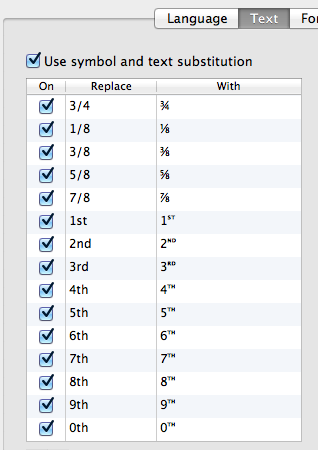I got the character substitutions set up the way I like them. The only remaining problems are little character anomalies in certain fonts (Helvetica is shown) that show up funny with substitute characters. They seem better with baseline shifted. Also I found the substitute characters' shifted capitals look better than the lower case ones when displayed in several different fonts, No worries, I can live with that and take advantage of the substitutions.
Here are some fonts I tried with the new mapping. These provide some illustration of my favorites. Below that is the mapping scheme I devised. You just type away in certain applications- TextEdit, Mail or any RTF word processor (guess). Full blown word processors will require their own font management techniques ā lā Pages.
Helvetica Font ½ ¾ ⅜ … 1ˢᵀ 2ᴺᴰ 3ᴿᴰ 4ᵀᴴ 5ᵀᴴ 6ᵀᴴ 7ᵀᴴ 8ᵀᴴ 9ᵀᴴ 10ᵀᴴ 100,000ᵀᴴ
Lucide Grande Font ½ ¾ ⅜ … 1ˢᵀ 2ᴺᴰ 3ᴿᴰ 4ᵀᴴ 5ᵀᴴ 6ᵀᴴ 7ᵀᴴ 8ᵀᴴ 9ᵀᴴ 10ᵀᴴ
Myriad Web Pro Font ½, ¾, ⅜ … 1ˢᵀ, 2ᴺᴰ, 3ᴿᴰ, 4ᵀᴴ, 5ᵀᴴ, 6ᵀᴴ, 7ᵀᴴ, 8ᵀᴴ, 9ᵀᴴ, 10ᵀᴴ
